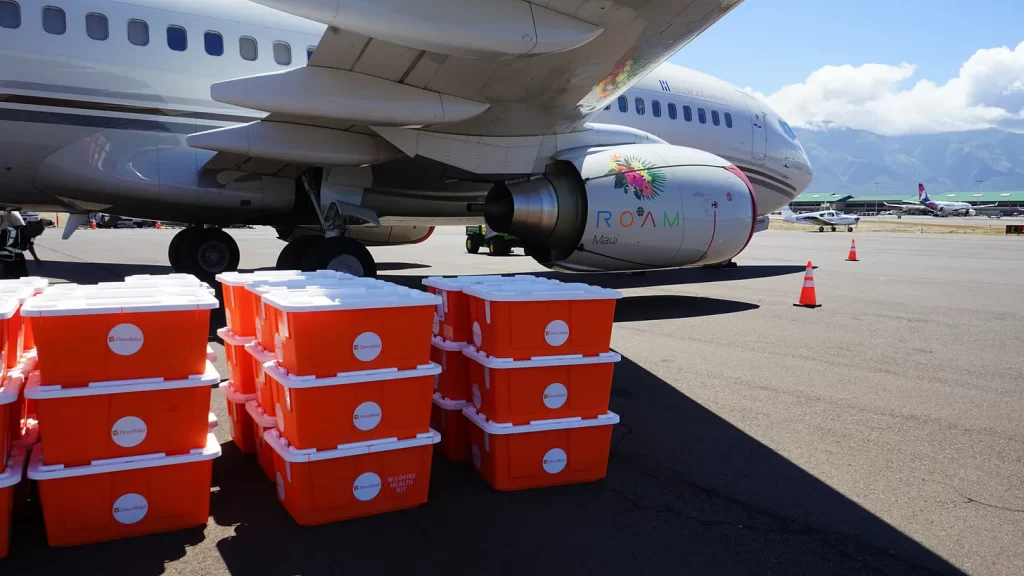UPDATE: Direct Relief provides aid to Hawaii in response to deadly wildfires

In the week following the Maui wildfires that destroyed thousands of structures and killed more than 100 people as of Aug. 16, Santa Barbara-based Direct Relief has provided immediate support to help the locals recover from the deadliest natural disaster in Hawaii’s history.
Direct Relief’s first large shipment of medical supplies arrived on Aug. 12 and since then, the humanitarian nonprofit has flown in over 3,000 pounds of medical aid to help the thousands of people displaced from their homes.
The 2,400 pounds of medical aid include pre-packed medical kits requested by local partners, respiratory medications, and other prescription and OTC medicines regularly needed by people displaced by wildfires and other disasters.
“Direct Relief is set up to respond rapidly,” Chris Alleway, a global emergency response manager at Direct Relief, told the Business Times.
On Aug. 13, Direct Relief announced that it had an initial cash commitment of $500,000 to aid affected communities and facilitate the timely and sustained delivery of urgently needed medical supplies to clinics, shelters, and state and local emergency response agencies with which it is working.
As of Aug. 16, Direct Relief has also received more than $420,000 in donations via its website earmarked specifically for the Maui response, Brea Burkholz, a public relations manager for Direct Relief, told the Business Times.
At least $200,000 of that was then immediately dispersed into four $50,000 grants to help fund operations by local medical responders.
Those grants help healthcare providers pay for the procurement of medicine, and medical supplies, and could even fund paying employees who have to work much longer hours during a crisis.
It’s important because, in the long term, experience shows that local health facilities can struggle to maintain services if many of their medical staff have been forced to relocate after losing their homes.
“It just helps alleviate some of the pain that financial burden can cause because a lot of the stuff during an emergency ramps up very quickly, a lot of expenses ramp up very quickly when trying to provide the best possible care. We just try to assist with that and then beyond the initial funding, we continue to evaluate funding other projects, initiatives, or operations that need to be covered,” Alleway said.
Alleway said that, for this response, Direct Relief was able to mobilize three shipments of medical aid within the first 24 hours.
They then supplied a mobile medical team — one of the first to arrive on the scene — to help support medical services. And on Aug. 12, the nonprofit flew in 1800 pounds of medical aid.
“We mobilize very quickly. The goal is always to get there as soon as possible, to reach out to those that are affected and provide them with the tools and the support that they need to take care of their communities and provide those health services,” he said.
Direct Relief is currently distributing medicines and medical supplies to sites across the island, including shelters, mobile medical clinics, and first responders.
Alleway said one of the biggest concerns when a natural disaster hits is the impact it could have on locals with chronic diseases.
This includes, for example, people not managing their diabetes because there is no access to insulin or people who need dialysis treatments not having that as well, turning into a health crisis.
“Chronic illness can go from better or worse very quickly if they don’t have access to medicine so folks are unable to make it down to a community clinic or their personal supply is depleted, or they evacuated without being able to grab their medication, this next phase really is focusing on making sure that they have a steady flow of access to that in order to keep them safe,” Alleway said.
Alleway said Direct Relief has been in contact with all 19 of the pre-existing healthcare partners across Hawaii, has shared currently available inventory, and received their current assessments and perspectives.
“Right now, it is about listening and learning what the biggest needs are,” he said.
Direct Relief CEO Thomas Tighe said while federal and state aid will be needed for clearing public areas and rebuilding infrastructure, the immediate support needed by people is best met by “fast-moving non-profits.”
“I changed my career about six years ago and just knowing that I could be a part of such a great organization and team that really do a very effective job by mobilizing quickly and getting in front of these federal agencies to help fill the gap is fulfilling,” Alleway said.
email: [email protected]









